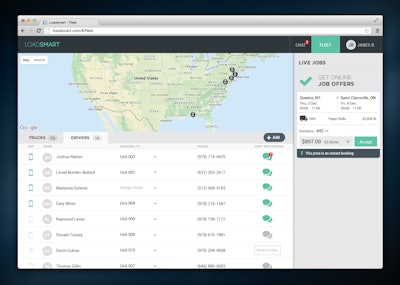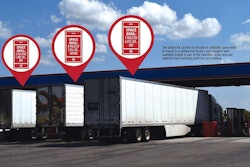 On Loadsmart’s desktop fleet management page, the fleet manager or dispatcher can see the location of all tracked trucks, enter chat rooms with drivers, as well as accept any relevant Live Jobs (on the right).
On Loadsmart’s desktop fleet management page, the fleet manager or dispatcher can see the location of all tracked trucks, enter chat rooms with drivers, as well as accept any relevant Live Jobs (on the right).The reputation of any technology company with brokerage authority hinges on the quality of the motor carriers it uses.
Besides monitoring DOT safety ratings and insurance credentials of carriers, brokerage companies use other online tools to determine load offers to carriers. To help attract and retain good carriers, several companies now offer free, online fleet management systems for fleets to dispatch their equipment and drivers.
Transfix, for instance, is currently developing a full, and free, transportation management system for carriers.
“What we’re seeing is that TMS systems are really expensive. We think a pain point for small carriers is that they can’t upgrade their technology,” says Jonathan Salama, chief technology officer of Transfix. “As a dispatcher, you can track trucks for free and assign them to one of our loads. Very soon, you can also manage loads that have not gone through us. Everything could be done within our platform.”
The company is working on algorithm that will determine if trucks in the system are loaded or empty. This information will help to further narrow the loads presented to carriers to make the tendering process more efficient, he says.
Speed and trust are essential for success in the spot market. All of the new technologies and companies mentioned are looking to speed the decision process by creating more transparency in freight transactions. The coming year, it will be interesting to see who will gain the upper hand.
Online load boards have traditionally not handled functions that come after rates are negotiated such as freight tracking and billing. Some new online services can manage transactions end to end.
In many ways, trucking is becoming more like the travel industry by sharing instant pricing information.
With 90 percent of motor carriers operating less than six trucks, mobile apps give brokers and shippers a way to automate communications with owner operators and small fleets.
A mobile app called Uber gives passengers instant rates between any local origin and destination and connects them to drivers to make a pickup within minutes. How could booking a truckload shipment ever been this easy?












